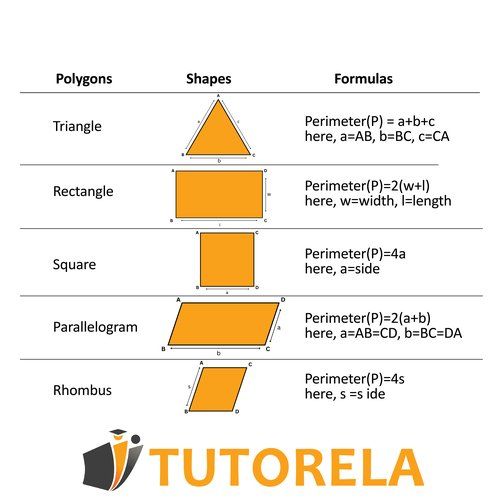As long as we are dealing with a shape characterized by straight lines, the perimeter calculation will be performed by adding together all of the side lengths. This is a simple arithmetic operation that does not require any special skills. For example:
How do we calculate the perimeter of polygons?
How do we calculate the perimeter of polygons?
The perimeter of a shape with sides of 5, 9, 4, 6 and 7, will be 31. All you need to do is simply add up all of the sides.
Why can such a question be challenging? Owing to the fact that in tests, they don't want to examine you on arithmetic operations like addition, but rather on your proficiency in the properties of specific shapes. Therefore, you need to know the properties of polygons as they are.

Test yourself on perimeter of a triangle!
Look at the rectangle below.
Side AB is 2 cm long and side BC has a length of 7 cm.
What is the perimeter of the rectangle?
Geometry problems require you to answer various questions:
- What is the perimeter of a shape.
- Calculating the area of a shape.
- Finding the length of a side and more...
How do we calculate the perimeter of polygons?
As long as we are dealing with a shape characterized by straight lines, the perimeter calculation will be performed by adding together all of the side lengths. This is a simple arithmetic operation that does not require any special skills. For example:
The perimeter of a shape with sides of 5, 9, 4, 6 and 7, will be 31. All you need to do is add up all the sides.
Why can such a question be challenging? Owing to the fact that in tests, they don't want to examine you on arithmetic operations like addition, but rather on your proficiency in the properties of specific shapes. Therefore, you need to know the properties of polygons as they are.
Example: Calculating the perimeter of a parallelogram
For example, you may encounter a question as seen below.
Given a parallelogram with sides of 5 and 6, determine the perimeter of the parallelogram.
In order to correctly answer this question, you need to know the properties of a parallelogram. We know that parallel sides in a parallelogram are equal, thus you can conclude that the length of the other sides are 5 and 8. Therefore, the perimeter of the parallelogram in this case will be 26 (5 + 8 + 5 + 8).
Additional examples:
Question: Given an isosceles triangle with a perimeter of 48. Leg a = 12. Determine the value of the base?
Answer: Given that this is an isosceles triangle, leg b is also equal to 12. Therefore, the base equals 24. (12+12 = 24)
Question: Given an isosceles triangle with a base of 26. The length of side a is 8. What is the perimeter of the triangle?
Answer: Since the triangle is isosceles, side b is also equal to 8. Therefore, the perimeter is 8 + 8 + 26 = 42.
Question: Given an equilateral triangle with side a equal to 9. What is the perimeter of the triangle?
Answer: Since the triangle is equilateral, all sides are equal. Therefore, the perimeter of the triangle is 27.
Question: Given a rectangle with adjacent sides of length 7 and 9. Determine the perimeter of the rectangle?
Answer: Since in a rectangle opposite sides are equal, we can conclude that the other sides are equal to 7 and 9. Therefore, the perimeter of the rectangle is 32.
Look at the rectangle below.
Side AB is 4.8 cm long and side AD has a length of 12 cm.
What is the perimeter of the rectangle?
Look at the rectangle below.
Side DC has a length of 1.5 cm and side AD has a length of 9.5 cm.
What is the perimeter of the rectangle?
Look at the triangle below:
What is the perimeter of the triangle?
Examples with solutions for Perimeter of a Triangle
Exercise #1
Look at the rectangle below.
Side AB is 2 cm long and side BC has a length of 7 cm.
What is the perimeter of the rectangle?
Video Solution
Step-by-Step Solution
Given that in a rectangle every pair of opposite sides are equal to each other, we can state that:
Now we can add all the sides together and find the perimeter:
Answer
18 cm
Exercise #2
Look at the rectangle below.
Side AB is 4.8 cm long and side AD has a length of 12 cm.
What is the perimeter of the rectangle?
Video Solution
Step-by-Step Solution
In the drawing, we have a rectangle, although it is not placed in its standard form and is slightly rotated,
but this does not affect that it is a rectangle, and it still has all the properties of a rectangle.
The perimeter of a rectangle is the sum of all its sides, that is, to find the perimeter of the rectangle we will have to add the lengths of all the sides.
We also know that in a rectangle the opposite sides are equal.
Therefore, we can use the existing sides to complete the missing lengths.
4.8+4.8+12+12 =
33.6 cm
Answer
33.6 cm
Exercise #3
Look at the rectangle below.
Side DC has a length of 1.5 cm and side AD has a length of 9.5 cm.
What is the perimeter of the rectangle?
Video Solution
Step-by-Step Solution
Since in a rectangle every pair of opposite sides are equal to each other, we can state that:
Now we can add all the sides together and find the perimeter:
Answer
22 cm
Exercise #4
Look at the triangle below:
What is the perimeter of the triangle?
Video Solution
Step-by-Step Solution
The perimeter of the triangle is equal to the sum of all sides together, therefore:
Answer
24
Exercise #5
Given the triangle:
What is its perimeter?
Video Solution
Step-by-Step Solution
The perimeter of a triangle is equal to the sum of all its sides together:
Answer
31
More Questions
Perimeter of a Rectangle
- Calculate the Perimeter: Finding Border Length in a 2×4×5 Rectangular Diagram
- Calculate Parallelogram Area: Rectangle with Perimeter 24 Inside
- Calculate the Perimeter: Rectangle Composed of Two Equal Squares
- Calculate Rectangle Area: Given Perimeter 30cm and Height 5cm
- Find the Rectangle Perimeter: When 4cm Square Equals 1cm-Sided Rectangle Area
Perimeter of a Parallelogram
- Calculate Parallelogram Area: 38cm Perimeter with Proportional Sides
- Calculate Parallelogram Height: Area 24 cm², Perimeter 24 cm with Double-Length Side
- Calculate Parallelogram Area: 22cm Perimeter with 2cm Height
- Calculate Parallelogram Area: 22cm Perimeter with 3cm Height
- Parallelogram Side Length: Finding Missing Side Given 9cm and 30cm Perimeter
Perimeter of a Trapezoid
- Calculate Trapezoid Perimeter: Inside an Isosceles Triangle with Height 8
- Calculate Trapezoid Perimeters: Comparing Two Shapes with 7-Unit Parallel Sides
- Compare Two Trapezoids: Analyzing Measurements x+5, 17, and Variable y
- Calculate the Perimeter of an Isosceles Trapezoid with Sides 3, 5, and 7
- Compare Trapezoids: Are Two Trapezoids with Sides x and x+16 Congruent?
Perimeter of a Triangle
- Calculate the Perimeter of an Equilateral Triangle with 5-Unit Sides
- Find X in an Equilateral Triangle with 33cm Perimeter
- Calculate the Perimeter: Isosceles Triangle with Sides 6 and Base 4
- Solve for X: Finding the Side Length in an Isosceles Triangle with Perimeter 50
- Triangle Side Lengths: Solve for X When 2X + 3X + 3.5X = 17
- Area
- Trapezoids
- Symmetry in Trapezoids
- Diagonals of an isosceles trapezoid
- Area of a trapezoid
- Perimeter of a trapezoid
- Types of Trapezoids
- Isosceles Trapezoid
- Parallelogram
- The area of a parallelogram: what is it and how is it calculated?
- Perimeter of a Parallelogram
- Identifying a Parallelogram
- Rotational Symmetry in Parallelograms
- From the Quadrilateral to the Parallelogram
- Kite
- Area of a Deltoid (Kite)
- Congruent Triangles
- Parallel lines
- Angles In Parallel Lines
- Alternate angles
- Corresponding angles
- Collateral angles
- Vertically Opposite Angles
- Adjacent angles
- The Pythagorean Theorem
- Elements of the circumference
- Circle
- Diameter
- Pi
- Area of a circle
- The Circumference of a Circle
- The Center of a Circle
- Radius
- How is the radius calculated using its circumference?
- Rectangle
- From a Quadrilateral to a Rectangle
- From a Parallelogram to a Rectangle
- Calculating the Area of a Rectangle
- The perimeter of the rectangle
- Congruent Rectangles
- The sides or edges of a triangle
- Similarity of Triangles and Polygons
- Triangle similarity criteria
- Triangle Height
- Midsegment
- Midsegment of a triangle
- Midsegment of a trapezoid
- The Sum of the Interior Angles of a Triangle
- Exterior angles of a triangle
- Relationships Between Angles and Sides of the Triangle
- Relations Between The Sides of a Triangle
- Square
- Area of a square
- From Parallelogram to Square
- Rhombus, kite, or diamond?
- The Area of a Rhombus
- Perimeter
- Triangle
- Types of Triangles
- Obtuse Triangle
- Equilateral triangle
- Identification of an Isosceles Triangle
- Scalene triangle
- Acute triangle
- Isosceles triangle
- The Area of a Triangle
- Area of a right triangle
- Area of Isosceles Triangles
- Area of a Scalene Triangle
- Area of Equilateral Triangles
- Perimeter of a triangle
- Cuboids
- Cubes
- How to calculate the surface area of a rectangular prism (orthohedron)
- How to calculate the volume of a rectangular prism (orthohedron)
- Lateral surface area of a rectangular prism
- Right Triangular Prism
- Bases of the Right Triangular Prism
- The lateral faces of the prism
- Lateral Edges of a Prism
- Height of a Prism
- The volume of the prism
- Surface area of triangular prisms
- Areas of Polygons for 7th Grade
- Right Triangle
- Area of a right-angled trapezoid
- Area of an isosceles trapezoid
- Corresponding exterior angles
- Alternate interior angles
- Median in a triangle
- Center of a Triangle - The Centroid - The Intersection Point of Medians
- How do we calculate the area of complex shapes?
- How to calculate the area of a triangle using trigonometry?
- How do we calculate the perimeter of polygons?
- All terms in triangle calculation
- Parts of a Circle
- Diagonals in a rectangle









